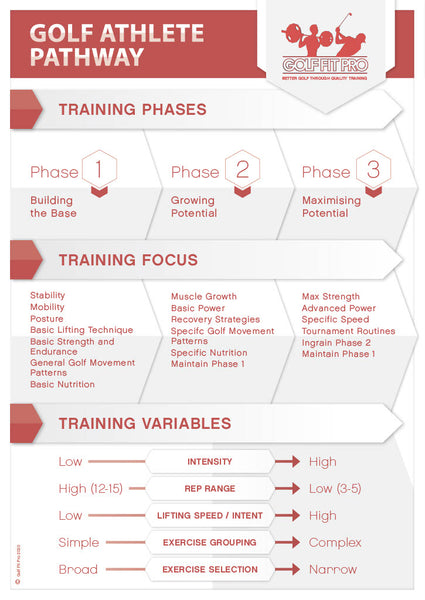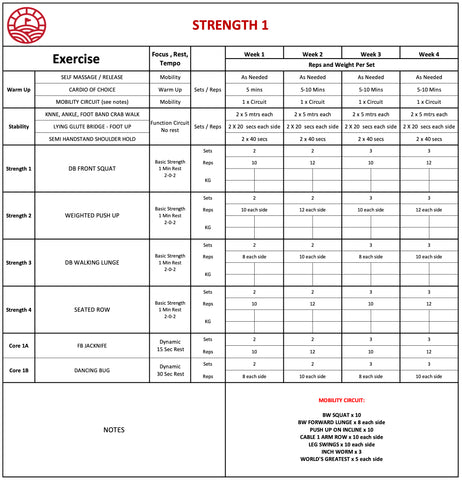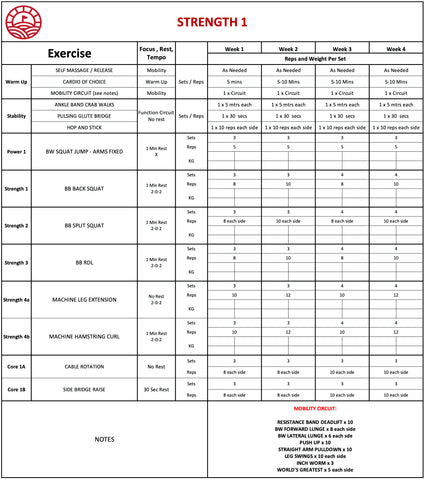The Golf Athlete Pathway (GolfWRX.com)
The Golf Athlete Pathway represented in the image below is essentially my long term approach to training golfers, boiled down to a 1 page document. It aims to give a broad overview of the journey that an aspiring elite player would take when training under my supervision or guidance.

I realize that the majority of you reading this article are not aspiring elite players, and might well be happy just doing a really good job of Phase 1, thereby reaping the rewards of a body that moves better, feels healthier, has a reduced risk of injury and a greater potential to execute quality golf shots.
Whether you are dreaming of playing on tour, or just playing without getting hurt, I hope that my explanation of the 3 training phases and examples of workouts and exercises will give you a thorough understanding of how I train golfers.

The first phase is focused on setting up a foundation of solid lifting technique and sorting out mobility, stability, and posture issues, whilst developing good exercise and nutrition habits.
Stability – Training key muscle groups to stabilise and balance the body in both gym movements and golf swing. Key areas of focus are foot / ankle, hip, core, shoulders, neck / head.
Mobility – Increasing range of motion in joints that require more movement.
Posture – Developing awareness of neutral spine position, understanding individual postural traits, training the deep muscle system to automatically hold good postural positions.
Basic Lifting Technique – Mastering the fundamentals of squat, lunge, push, pull, rotate and brace.
Basic Strength and Muscular Endurance – Improving ability to move bodyweight and light resistance efficiently, conditioning muscles to tolerate and recover from training loads.
General Golf Movement Patterns – Learning how to rotate efficiently at the hips and T-Spine. Developing basic scapular control and applying it to golf swing mechanics.
Basic Nutrition – developing understanding of the importance of whole unprocessed foods, achieving a balance of macro nutrients (carbs, fats, proteins) and learning the basic skills of food preparation.
Intensity – Relatively light loads, less than 50% of max. Using bodyweight, resistance bands, kettlebells, dumbbells.
Rep Range – fairly high, generally in the 10-15 range.
Lifting Speed / Intent – slow and controlled, focusing on technique.
Exercise Grouping – quite simple, when exercises are paired together it’s generally different muscle groups and movements (e.g. squat and push for example)
Exercise Selection – broad, aiming to learn many variations of squat, lunge, push, pull in order to help develop physical literacy.

Now we have mastered the basics, in Phase 2 it’s time to get bigger and stronger, whilst paying more specific attention to movement patterns, nutrition and recovery.
Muscle Growth – increasing muscle mass throughout the body, with particular focus on legs and back.
Basic Power – learning how to move light loads fast, lots of jumping and throwing.
Recovery Strategies – understanding importance of post training and play recovery such as self massage, hot/cold contrast, cold water immersion, stretching etc.
Specific Golf Movement Patterns – collaborating with the golf coach to help ingrain body movement that coach wants to see implemented or ingrained in the golf swing.
Specific Nutrition – consulting with nutritionist / dietician to deliver individual nutrition plans and recommendations on supplements.
Intensity – starting to lift heavier loads, around 70% of maximum
Rep Range – 8 to 12 for most exercises
Lifting Speed / Intent – still quite slow, generally using 2-0-2 tempo (2 seconds up – no pause – 2 seconds down).
Exercise Grouping – starting to get more complex, often grouping exercises that use the same muscle group or movement.
Exercise Selection – Getting narrower, with a focus on gradually increasing volume on key exercises.

This is the final phase of the pathway, aiming to transfer the physical gains developed in the first 2 phases to elite performance.
Max Strength – Training neural system and muscle contraction co-ordination to increase max force output.
Advanced Power – Focusing on vertical and rotational power production. Jumping, throwing and rotating as fast as possible with medium to heavy loads.
Specific Speed – Aiming for increases in club head speed, often working together with the coach to ensure there is no detriment to technique.
Tournament Routines – Combining training, warm up, recovery, nutrition and hydration habits into a repeatable routine for tournament weeks.
Intensity – getting quite high now, lifting heavy loads at close to maximum effort.
Rep Range – generally quite low, looking at 3-5 for major lifts and 8-10 for supporting exercises.
Lifting Speed / Intent – aiming to move everything as fast as possible in concentric phase (when the muscles are shortening – up phase in a squat or bench press for example).
Exercise Grouping – more complex now, often combining exercises in supersets or mini circuits.
Exercise Selection – becoming much more narrow, focusing on repeating key movements with heavier loads. Still some variety in supporting exercises.

If you are interested in progressing along the Golf Athlete Pathway, then check out the services on offer at Golf Fit Pro
Pokračovat ve čtení...
The Golf Athlete Pathway represented in the image below is essentially my long term approach to training golfers, boiled down to a 1 page document. It aims to give a broad overview of the journey that an aspiring elite player would take when training under my supervision or guidance.

I realize that the majority of you reading this article are not aspiring elite players, and might well be happy just doing a really good job of Phase 1, thereby reaping the rewards of a body that moves better, feels healthier, has a reduced risk of injury and a greater potential to execute quality golf shots.
Whether you are dreaming of playing on tour, or just playing without getting hurt, I hope that my explanation of the 3 training phases and examples of workouts and exercises will give you a thorough understanding of how I train golfers.

Phase 1 – Building the Base
The first phase is focused on setting up a foundation of solid lifting technique and sorting out mobility, stability, and posture issues, whilst developing good exercise and nutrition habits.
Training Focus
Stability – Training key muscle groups to stabilise and balance the body in both gym movements and golf swing. Key areas of focus are foot / ankle, hip, core, shoulders, neck / head.
Mobility – Increasing range of motion in joints that require more movement.
Posture – Developing awareness of neutral spine position, understanding individual postural traits, training the deep muscle system to automatically hold good postural positions.
Basic Lifting Technique – Mastering the fundamentals of squat, lunge, push, pull, rotate and brace.
Basic Strength and Muscular Endurance – Improving ability to move bodyweight and light resistance efficiently, conditioning muscles to tolerate and recover from training loads.
General Golf Movement Patterns – Learning how to rotate efficiently at the hips and T-Spine. Developing basic scapular control and applying it to golf swing mechanics.
Basic Nutrition – developing understanding of the importance of whole unprocessed foods, achieving a balance of macro nutrients (carbs, fats, proteins) and learning the basic skills of food preparation.
Training Variables
Intensity – Relatively light loads, less than 50% of max. Using bodyweight, resistance bands, kettlebells, dumbbells.
Rep Range – fairly high, generally in the 10-15 range.
Lifting Speed / Intent – slow and controlled, focusing on technique.
Exercise Grouping – quite simple, when exercises are paired together it’s generally different muscle groups and movements (e.g. squat and push for example)
Exercise Selection – broad, aiming to learn many variations of squat, lunge, push, pull in order to help develop physical literacy.
Phase 1 Workout Example

Phase 1 Exercise Examples
Phase 2 – Growing Potential
Now we have mastered the basics, in Phase 2 it’s time to get bigger and stronger, whilst paying more specific attention to movement patterns, nutrition and recovery.
Training Focus
Muscle Growth – increasing muscle mass throughout the body, with particular focus on legs and back.
Basic Power – learning how to move light loads fast, lots of jumping and throwing.
Recovery Strategies – understanding importance of post training and play recovery such as self massage, hot/cold contrast, cold water immersion, stretching etc.
Specific Golf Movement Patterns – collaborating with the golf coach to help ingrain body movement that coach wants to see implemented or ingrained in the golf swing.
Specific Nutrition – consulting with nutritionist / dietician to deliver individual nutrition plans and recommendations on supplements.
Training Variables
Intensity – starting to lift heavier loads, around 70% of maximum
Rep Range – 8 to 12 for most exercises
Lifting Speed / Intent – still quite slow, generally using 2-0-2 tempo (2 seconds up – no pause – 2 seconds down).
Exercise Grouping – starting to get more complex, often grouping exercises that use the same muscle group or movement.
Exercise Selection – Getting narrower, with a focus on gradually increasing volume on key exercises.
Phase 2 Workout Example

Phase 2 Exercise Examples
Phase 3 – Maximising Potential
This is the final phase of the pathway, aiming to transfer the physical gains developed in the first 2 phases to elite performance.
Training Focus
Max Strength – Training neural system and muscle contraction co-ordination to increase max force output.
Advanced Power – Focusing on vertical and rotational power production. Jumping, throwing and rotating as fast as possible with medium to heavy loads.
Specific Speed – Aiming for increases in club head speed, often working together with the coach to ensure there is no detriment to technique.
Tournament Routines – Combining training, warm up, recovery, nutrition and hydration habits into a repeatable routine for tournament weeks.
Training Variables
Intensity – getting quite high now, lifting heavy loads at close to maximum effort.
Rep Range – generally quite low, looking at 3-5 for major lifts and 8-10 for supporting exercises.
Lifting Speed / Intent – aiming to move everything as fast as possible in concentric phase (when the muscles are shortening – up phase in a squat or bench press for example).
Exercise Grouping – more complex now, often combining exercises in supersets or mini circuits.
Exercise Selection – becoming much more narrow, focusing on repeating key movements with heavier loads. Still some variety in supporting exercises.
Phase 3 Workout Example

Phase 3 Exercise Examples
If you are interested in progressing along the Golf Athlete Pathway, then check out the services on offer at Golf Fit Pro
Pokračovat ve čtení...








